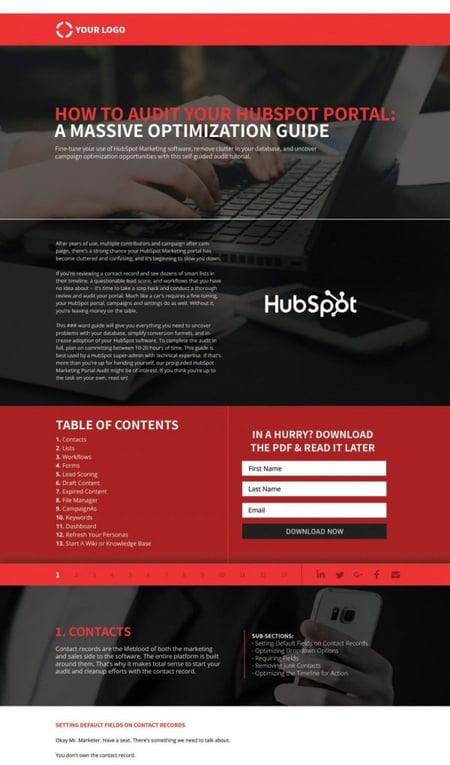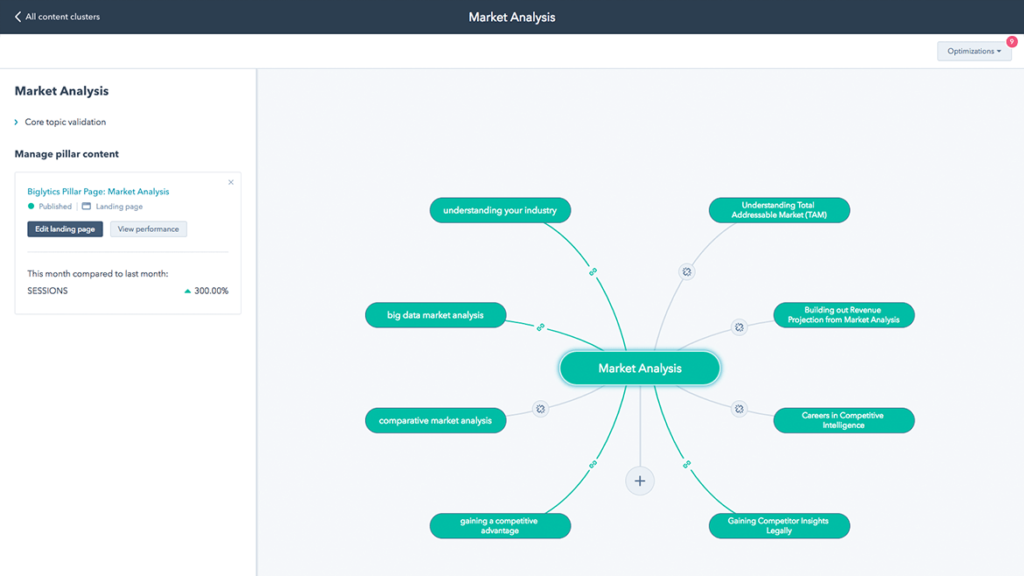Written By:
Tim Stobierski
If you’re a marketer or work with a marketer, then chances are good that you’ve heard the phrase “Pillar Content” or “Pillar Page” the last few months. “Pillar content is the future of SEO!” some say. “Pillar content is going to replace keywords!” chorus others.
That may well be true, but it doesn’t really help you understand the fundamental question: What the heck is Pillar Content?
What is Pillar Content?

Pillar content (also called Pillar Pages or Content Pillars) refers to top-level pages on your website which forms the foundation of your content marketing strategy. They are comprehensive, authoritative pages about a certain topic or question that are widely used by companies for lead generation.
While a blog post typically zooms in on a single question or on a single aspect of a topic, a pillar page aims to be all-encompassing. It wants to answer all questions related to a particular topic, and explain all aspects of that topic fully.
Why? Well, by answering all possible questions about a topic and providing a thorough and complete explanation of it, the page will, in theory, perform much better in SEO, for a few reasons:
- Pillar pages do a good job of matching the searcher’s intent and answering the searcher’s question, which means that when searchers land on your page, they are not “pogoing” back to the search results to find another answer. Google likes it when searchers stay on your page, and will use that information to inform whether or not it ranks your page high in search results.
- Pillar pages, by covering a topic fully, essentially anticipate what a searcher’s next question is going to be. And the question after that. And the question after that. By answering all of those questions in a single place, you are building trust with the searcher (since they no longer need to do a ton of searches). You’re also keeping them on the page longer, which increases your likelihood of converting them into a subscriber or lead.
- Pillar pages, since they are typically thorough resources and guides, are link-worthy. People want to link to them. And the more people link to them, the more authority your pillar page and your website over all will have. Google rewards websites with high authority and a high number of links, so the importance of this cannot be overstated.
- Pillar pages are more likely to be shared on social. Social shares might not directly impact your SEO rankings, but they will get you a wider audience. And some of your social audience could link to you from their website, again boosting the domain authority of your website.
- Pillar pages are heavily linked to from your primary navigation, as well as semantically related blog posts and pages across your website. They also link to those related resources, creating a very clear signal to Google about the relationship and significance of this content.
And those are just the marketing benefits of pillar content. Pillar content also has the potential to be helpful to your sales team, because it is essentially sales collateral. When your sales team has prospects with questions, they can direct the prospect to your pillar page to educate them, drastically reducing the back and forth required to answer questions. An informed prospect makes for an easier sell, in the long run.
The idea is that “pillar content” or “pillar pages” are the resources on your website that sort of hold everything up. They form the foundation upon which all of your SEO and marketing efforts are built.
Pillar Content vs. Flagship Content vs. Cornerstone Content
If you’ve been in the marketing game for a while, this is the part where things are starting to sound a little familiar. “That sounds a lot like Flagship Content,” you grumble. Or, “Isn’t that the same thing as Cornerstone Content?”
I’m going to let you in on a little secret: You’re right. Pillar content isn’t all that different from Flagship Content or Cornerstone content—it’s the same general concept, branded a little differently.
What is Cornerstone Content?
Cornerstone content refers to the pages on your website (blog posts, FAQs, or other pages) which form the foundation of your content strategy. They are comprehensive, authoritative pages about a certain topic or question that are widely used by bloggers for SEO benefit.
Cornerstone content takes its name from the architectural term “cornerstone,” which in masonry is literally the first stone set when constructing a building. It is the foundation upon which everything else is built, and as such, it has incredible structural significance: If your cornerstone is too small, or weak, or faulty, then your whole building will be as well.

In the world of websites and SEO, cornerstone content is virtually indistinguishable from Pillar Pages. In practice, they are the same thing. Cornerstone content is written to be authoritative, complete, and link-worthy. The earliest usage of the term “cornerstone content” that I could find was a blog post by Brian Clark over at CopyBlogger.com, which was written back in 2007. Today, the concept is very much associated with Yoast.
What is Flagship Content?
Flagship content, similar to Cornerstone and Pillar content, refers to the pages on your website (blog posts, FAQs, or other pages) which form the foundation of your content strategy. They are comprehensive, authoritative pages about a certain topic or question that rank well in organic search. It is the content that your website is known for.
Flagship Content takes its name from the navy. Historically, a “flagship” was the best ship in a naval fleet, which bore a country’s flag (hence the name) and carried its admiral. Today, the term broadly refers to the “best” or “most important” product created and sold by a company. For example, the iPhone is Apple’s flagship product.

The idea carries over into SEO and content creation. Flagship content, like pillar content, is meant to be a complete resource on a topic. It is the content that you are proudest of, and that others will want to share and link to.
Flagship content got it’s start back around the same time as Cornerstone content in 2007, and was popularized by this ebook by Chris Garrett.
Pillar Content History
I tried finding the original use of the term “Pillar Content” or “Content Pillar” or “Pillar Page” on google, and I was unfortunately unable to pinpoint who used it first or when it first appeared. But the concept was definitely around all the way back in 2013 (which is ages ago in the world of SEO), pointing to the fact that it isn’t exactly new.
That being said, whoever first developed the concept of pillar content is being overshadowed by HubSpot, who is really starting to push the idea, along with the concept of “Topic Clusters.” They’re so sure that Pillar Content is going to be the future of SEO that they’ve even developed a tool to help you figure out what your topic clusters and pillar pages should be.

So, regardless of who came up with it first, moving forward there’s an extremely good chance that pillar content is going to be directly tied to HubSpot in everyone’s mind.
One important distinction to make between Pillar content and Cornerstone and Flagship content, though, is how it is positioned. While Cornerstone and Flagship content tend to simply be lengthier blog posts on a website, Pillar content should be positioned as a part of your top-level navigation. This way, it is easy for your website visitors to find, read, use, and share, which is what gives it extreme power as a lead generator.
Pillar content is also designed in a way where you are likely to capture leads from the traffic it helps you acquire. A common trait of pillar content pages is that they often include a form to download a PDF companion for the content, even though 100% of the content is displayed directly on the page for search engines to see. This works because visitors may initially be intrigued by the thoroughness of your content, but may not have the time to read in a single sitting. Offering a downloadable version of the content is a convenient way for them to take the material with them so that they can revisit at a later time, or share with their colleagues.
If your goal is to dramatically increase your traffic, rank highly for broad, heavily searched, competitive terms, acquire links, and capture leads at the same time—a pillar content strategy is likely going to be the right approach for you to pursue.
The Bottom Line
Ultimately, what you call the strategy doesn’t really matter. HubSpot is calling it Pillar Content, and it’s a phrase that we like, use, and that a lot of other marketers will soon be using.
But if you’re familiar with the concept of Flagship Content or Cornerstone Content, don’t freak out thinking you need to learn something brand new from scratch. All three of these content strategies are more similar than they are different: The aim is to create a complete, thorough resource that people are naturally going to want to link to and share, which will have a dramatic boost to your SEO and link-building efforts.
Paired with a fully-formed inbound marketing funnel, Pillar Content (or Flagship Content, or Cornerstone Content) can help you attract more visitors and convert them into leads and customers for your business.







